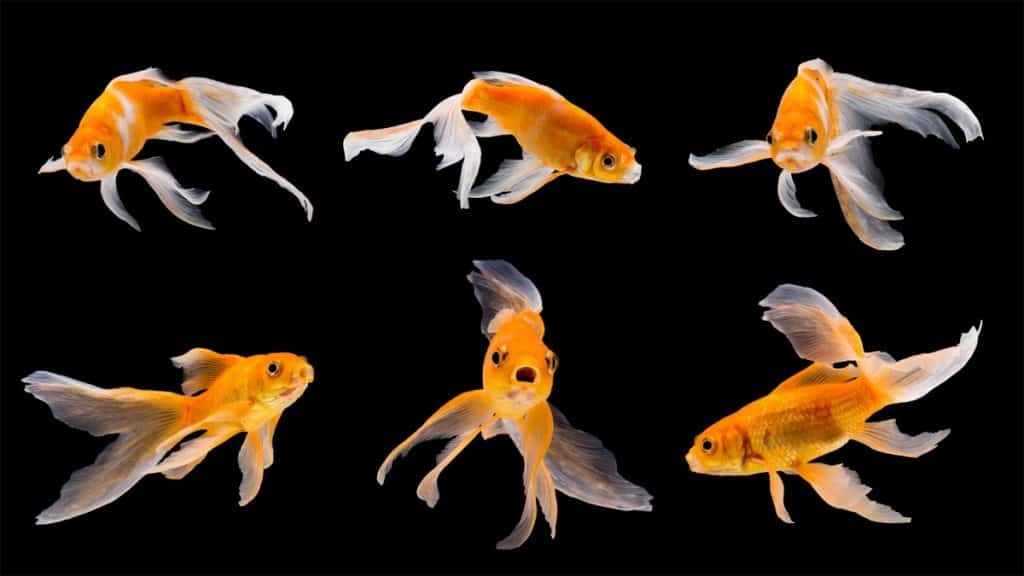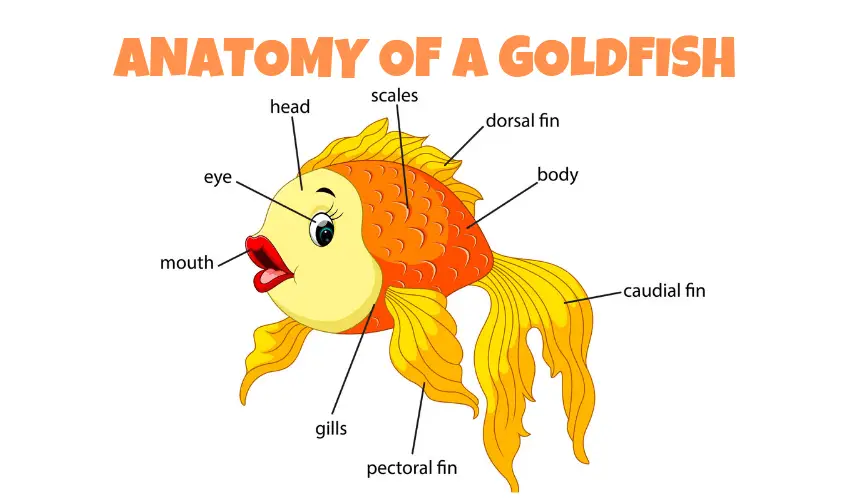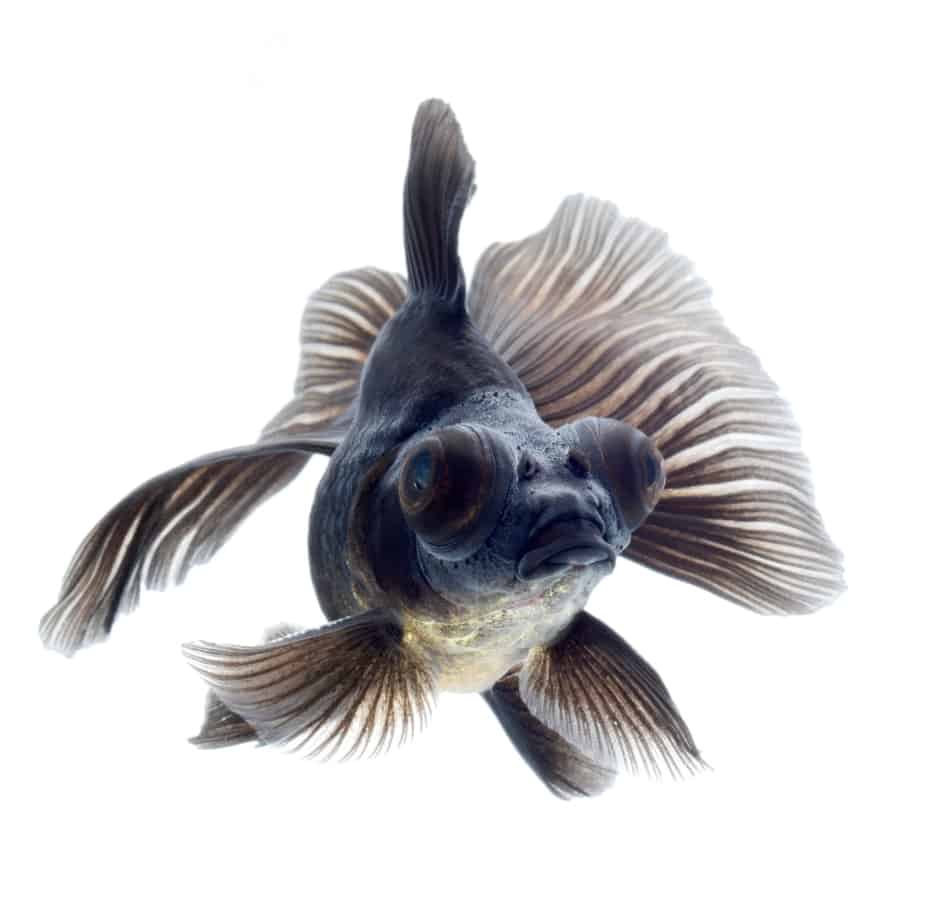Within the fish keeping world, you’d be pretty hard pressed to find someone that hasn’t at one time or another kept the gorgeous Goldfish. They make an ideal fish for any novice and experts alike, and once you’ve kept one, well you can’t help but keep more.
But, have you ever stopped to wonder what is going on inside and outside of your stunning golden friend? Do they have ears, can they smell, what internal organs do they have? If the answer is yes, then read on.
Table of Contents
External Anatomy Of A Goldfish
The anatomy of a Goldfish is really no different from that of any other member of the Cyprinidae family; Cyprinidae meaning toothless jaw. Other members of this family include Barbs, Rasboras, Danios, Bala Sharks, and Chinese Algae Eaters.
As a forager rather than a hunter the Goldfish has a long and streamlined body, but not one that is suited to overly speedy swimming. They come in various colorations and mixes of color such as white, yellow, orange, red, brown, and black. Coming off the body there is a variety of fins which need some closer inspection.

Goldfish Fins
The Goldfish has five sets of fins which follow the same pattern as most of the Cyprinidae family. These fins are:
- Dorsal (single)
- Caudal (single)
- Anal (single)
- Ventral (pair)
- Pectoral (pair
Dorsal – This fin is located on the back of most Goldfish except the Ranchu and Lionhead who do not have dorsal fins at all. It performs the task of ensuring stability in the water and helping them steer. The height of this fin can vary depending on the species in question, and health can be judged by how upright it is.
Caudal – Also known as the tail fin, the caudal provides thrust for swimming and acts as a rudder. There are two types of caudal fin, single and double. Species such as Common and Comet have the singular version enabling them to swim fairly quick. Fancy varieties, on the other hand, have double caudal fins causing them to swim slower.
Anal – Located just in front of the caudal fin on the lower half of the body, the anal fin is used for steering. In double caudal finned fish, the anal fins will be a pair, whilst the single caudal fin has a singular anal fin. Deformities in anal fins are common in fancy Goldfish.
Ventral – Used for stability, steering, and sudden stops the ventral fins are located on both sides of the fish. They are situated in between the anal and pectoral fin.
Pectoral – This pair of fins are situated just behind the gills. Fish use these for low-speed swimming, braking, and steering.

Goldfish Body And Head
Of course, there is more to the external anatomy of a Goldfish than simply fins. There is also opercula, the peduncle, lateral line, and much more so let’s explore.
The Body
Peduncle – This is the area of the Goldfish that join the caudal fin and body together. In Japan, Ranchus with thick peduncles are very desirable.
Lateral Line – Appearing to the eye like a series of dots running from head to tail of the Goldfish, the lateral line is actually a row of sensory organs. These detect vibrations, water current direction, and water temperature enabling the Goldfish to be aware of danger and avoid obstacles.
Scales – Scales cover the entire head and body of the Goldfish. They are arranged in a regular pattern and in high-quality Goldfish, are incredibly uniform.
Vent – The vent is the site of waste elimination and is located just in front of the anal fin. In females, the vent protrudes slightly and is circular in shape, whilst in males, it is indented and more narrow.

The Head
Opercula – Commonly known as the gill covers the opercula are hard bony flaps that cover and protect the gills. They are open in the back for easy release of water.
Head – The shape of a Goldfish’s head will vary dependent on the variety. For example, Ryukin have a pointed triangular head, whilst Ranchu have a broad, squared head covered in raspberry like growths.
Eyes – Goldfish have different shaped eyes, again dependent on their variety. There are telescopic eyes and bubble eyes, for example, which make for poor vision. Most varieties, however, can see well despite having little eye movement possible.
Nares – Commonly called nostrils, the nares are connected by a u-shaped passage lined with cells that detect odors. Each of these nostrils has a fleshy narial flap on the outside of it. Goldfish, as well as other fish, have a really good sense of smell, being able to detect one part million of a dissolved substance in water.
Mouth – Goldfish are suction feeders that in order to eat quickly expand their mouth cavities. This causes a pressure difference between the inside of the mouth and the outside environment causing food and water to be sucked in.
Internal Anatomy Of A Goldfish
Unlike the external anatomy of a Goldfish which can vary from variety to variety, the internal anatomy of a Goldfish is always the same. They have the same organs and features; they are in the same place, and they all look pretty much the same.

Head
Pharynx – This can be located at the very rear of the Goldfish mouth. The pharynx is where food particles are ground up into smaller more manageable pieces for digestion.
Pharyngeal Teeth – Though Goldfish lack traditional teeth they do have pharyngeal ones on the lower surface of the pharynx. These are continually shedding and replaced throughout the Goldfish’s life.
Chewing Surface – This is a hard chewing area that the teeth grind against. It is located above the teeth on the upper surface of the pharynx.
Gill Arches – The gill arches are bony structures that support the delicate gills. They have forward projections that look like spikes that strain out food and debris.
Gills – Made up of filaments containing capillary beds for gas exchange, the gills allow the Goldfish to take in oxygen and expel carbon dioxide.
Brain – The brain is where all sensory information is processed. It all produces automatic functions like respiration and higher behaviors such as decision making.
Otoliths – Goldfish have no external ears but they do have inner ones. These are enclosed in a bony capsule on each side of the skull. Their primary purpose is balance, not hearing, as the design is very rudimentary. However, when mixed with a complex set of bones that link the inner ear to the air bladder, they can pick up sound vibrations in the water.
Body
Heart – The Goldfish heart has two chambers containing one ventricle and one atrium. Deoxygenated blood is pumped to the gills for oxygenation and throughout all the other organs of the body.
Liver – The liver aids digestion by excreting digestive enzymes, storing fats and carbohydrates, and also destroying old blood cells.
Gall Bladder – Stores bile which is produced by the liver.
Intestines – The Goldfish has no stomach in which to store food. Instead, they have an intestinal bulb at the beginning section of the intestine which functions as temporary food storage. In the second section of the intestines, called the caudal intestine, protein absorption takes place.
Spleen – The spleen stores blood and recycles old red blood cells.
Gonads (testes/ovaries) – These are located beneath the swim bladder. Females have a single ovary that produces eggs, whilst males have paired testes for production of milt.
Swim Bladder – The swim bladder is a hollow filled sac that helps ensure buoyancy. Fancy Goldfish can be prone to swim bladder problems because of their modified bodies.
Kidney – The kidneys filter out nitrogen waste from the Goldfish’s blood.
Spine – The spine, as in humans, provides structural support and houses the spinal nerve.
Conclusion: The Anatomy Of A Goldfish
It may, or may not be useful to remember that over time we have altered, through selective breeding, the external anatomy of Goldfish. Fins, eyes, body shapes, color, scales, and even operculum have changed. This has resulted in many varieties being available alongside the common kind.
Despite this, the basics of Goldfish anatomy, internal and external, remain the same. They all have hearts, livers, eyes, lateral lines, multiple fins, and eyes. They are all made up of the same body stuff!
If you liked this article you’ll love these ones:
Do Goldfish smell?
[author title=”About the Author”]

I have been working in the tropical fish industry for over 30 years now and I’m still learning. Everyday is a school day in this hobby. In my spare time I play golf very badly!

